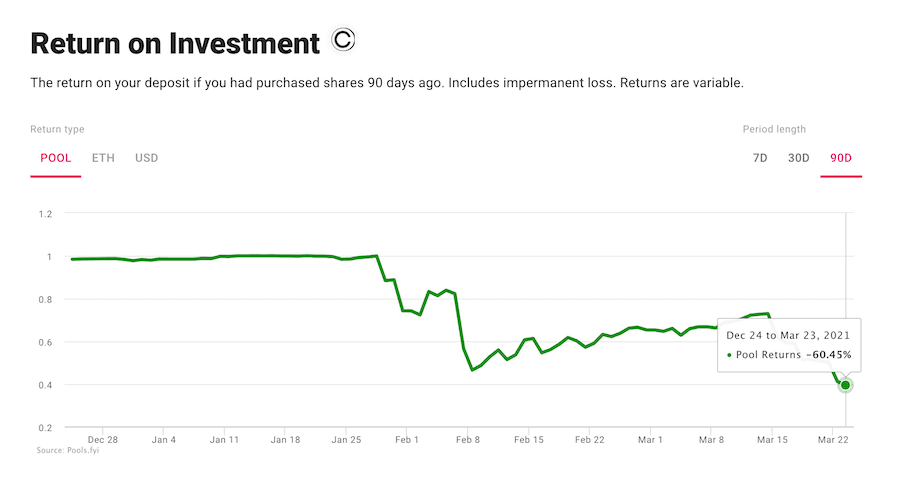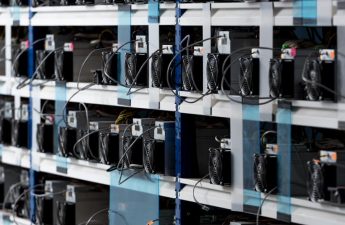
Liquidity mining on Uniswap can be profitable, but there are some inherent risks attached to the practice.
Liquidity mining risks such as smart contract risk, project risk and impermanent loss can endanger the funds of investors trying to earn passive income by adding liquidity to decentralized exchanges like Uniswap, so let’s find out what they’re all about.
Risk #1 of Liquidity Mining: Smart Contract Risk
Smart contract risk isn’t something specific to Uniswap. It’s a potential threat that all blockchain projects using smart contracts are susceptible to.

The more advanced a smart contract is, the longer its source code gets. And as the source code gets more complicated, the risk of bugs occuring in the code increases.
Investors dealing with DeFi platforms should consider the probability that bugs may exist in the smart contract. If hackers discover it before the community, everyone’s funds are at risk. Fortunately, decentralized blockchain projects are usually open source.
Extremely popular smart contracts like the one used by Uniswap are constantly being reviewed by independent experts, and the chances that none of them would spot a bug are extremely small.
Projects that launch sometimes pay for Audit companies such as Hacken and Quantstamp to review their code, this helps the project community feel more comfortable with a second look on the code and minimizes the risks of having it hacked.

Risk #2 of Liquidity Mining: Project Risk
Project risks are the most prevalent threat to the funds of every blockchain investor. It’s not just a specific Uniswap liquidity mining risk – it’s the most common reason why crypto enthusiasts lose money.
Any flaw in a crypto project can be considered a potential risk.
The software could be buggy and susceptible to hacker attacks, or simply not be as efficient and effective as promised.
Blockchain project risks come in many different forms:
- Key management risk – having your private keys stolen is the worst thing that can happen to a crypto owner. Software that is buggy or intentionally malicious can leak your private keys, which almost certainly will result in losing all the funds in your wallet.
- Performance and scalability risk – if a project is not optimized, the network can get congested when the volume increases. When that happens, fees and transaction times become so high that the blockchain becomes unusable.
- Privacy management risk – projects that require you to provide personal information might accidentally reveal your data to the public, which could potentially put you at risk.
Many more potential project risks exist.
Not all of them pose serious danger as they can be mitigated if addressed on time. But one type of project risk is especially malicious and can be very hard to avoid: pull rugs.
Risk #3 of Liquidity Mining: Rug Pull
Rug pulls happen when project founders don’t have good intentions from the start. Pull rug simply means that the developers decide to shut down the whole thing and run away with people’s funds. These can be avoided by staying away from centralized projects, but most importantly, to make your own due diligence on the project’s code, team background and vision.

Uniswap is the most popular decentralized exchange in the world, and the risk of a rug pull is practically non-existent. Don’t trust projects that won’t allow you to peek at the code. A well-known rug pull that happened on Uniswap was Trueample.
The project was heavily shilled on social media, but after the investors transferred 1,800 ETH to the smart contract ($3M+ today), the anonymous founder simply took all of it and disappeared.
When it comes to Uniswap liquidity mining risks, project risks like rug pulls are not one of the main concerns. Uniswap is built on solid fundamentals so technical issues are not as problematic as threats resulting from the unavoidable volatility of crypto markets.
Risk #4 of Liquidity Mining: Impermanent Loss
Impermanent loss is the most complicated issue facing liquidity providers on Uniswap, and unfortunately it’s also the most common. Impermanent loss won’t make you permanently lose your funds, but it can greatly diminish your returns in the short term.
The price of any crypto asset can skyrocket or plummet within minutes.
When that happens, the profitability of a liquidity pool can drastically fall in a very short period of time. If you were to withdraw your funds from the pool at that moment, you would be at loss.

Uniswap uses smart contracts that are designed to reduce the risks resulting from high volatility. Algorithms used by Uniswap will always balance the liquidity pool profitability in the long term, so if you wait long enough, you will be able to withdraw your tokens without losing anything.
Volatility will rarely make you lose your funds, but it diminishes your ROI. Technically, if the rate of interest falls down to 0.01%, you are not losing any money. But in practice, you’re missing the opportunity of putting your funds to work in a more profitable way.
Risk #5 of Liquidity Mining: Malicious Software
The last type of risk that can potentially endanger your funds while providing liquidity to Uniswap is not related to the exchange itself, but to third party software used along with Uniswap.
In order to use Uniswap, you need to connect your Ethereum wallet to it. Even if there are no problems with Uniswap, using a shady ETH wallet can put all your funds at risk. The best practice is to always check if your ETH wallet is recommended on the Ethereum website.
Generally, only the open source crypto wallets are considered to be 100% secure.
Some of the popular Ethereum wallets used together with Uniswap are not fully open source, and using them to send funds to Uniswap liquidity pools can be dangerous.
How to Mitigate the Risks When Liquidity Mining

Uniswap is a time-tested, popular solution, used by millions of people around the world without any problems. It’s a decentralized, open source platform considered to be quite secure.
Using a quality Ethereum wallet to provide liquidity to Uniswap is the most important thing that can prevent you from losing your funds. But there’s nothing you can do to avoid impermanent loss – any liquidity pool can stop being profitable at any time.
Keeping funds locked in a liquidity pool that has a 0.01% rate of interest is not technically risky. After all, you’re not really losing anything – you’re just wasting time and missing out on an opportunity to earn much more.
If you want to earn significant rewards in a short time, liquidity mining might not be for you. An alternative worth considering is a Bitcoin casino like Wolf.bet.
Playing at a casino involves risk, just like liquidity mining, but you can earn much more than if you kept your tokens in a low-profit Uniswap pool (and quickly too!).

Frequently Asked Questions
Smart contracts used by liquidity staking platforms are safe and you are unlikely to lose money in the long-term. In the short-term, the problem of impermanent loss can be a serious issue.
Liquidity mining on Uniswap is considered a somewhat secure practice, but there are still risks involved. You can never have a full guarantee that liquidity mining will turn out profitable in the end.
Liquidity staking can be a good investment if you use a profitable liquidity pool, but the risks of high crypto volatility can make your rewards diminish at any time and all of a sudden.
